|
Congratulations
Congratulations are due for the following black belts
Sensei Andrew
D. SANDAN
Sensei Mike R. SANDAN
David H. SHODAN
These fine Martial Artist demonstrate competency in all areas
of our art at the highest level and received their new rank in Ping Shen Tao . Their examination of 4 hour test was held at
the Pence Self-Defense Academy 3/4/2012.
Also A special thanks to the their black belt Brothers who helped out all day
Trev, Chris, & Shawn! I'm very proud of all of you.
Student Code of Honor
"I vow to never use my Martial Art training for
any purpose that would convey a negative image of myself or my Family. My training is to improve me both mentally and
physically, so that I am able to help others do the same, in and out of my Dojo."
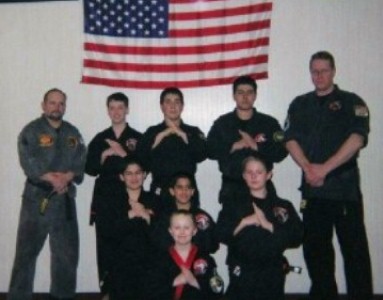
|
| Shihan Nesta and the jr. Black Belts |
The best weapon against an enemy is another enemy.
Friedrich Nietzsche
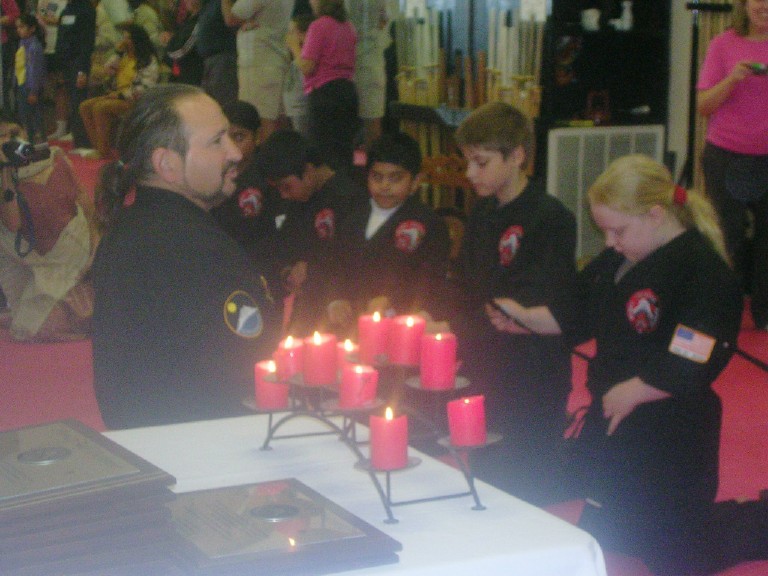
RULES OF THE DOJO 1. We should always have FUN in class! 2. No member shall engage
in any behavior that brings discredit to themselves or their dojo. 3. Students shall maintain a well
kept and sanitary appearance. This means nails should cut and members should wash and clean themselves. Uniforms should be
neat and be washed. Jrs, dont play at home or eat in your GI. Be proud of your appearance and don't let your uniform become
dirty. 4. Students shall kneel when they put on or take off their belt out of respect for all who have
trained before them . 5. NO horse playing in class, ever! 6. Members must be in
proper uniform with all proper patches in place by the day of testing if they expect to test for their first rank promotion. 7. Absolutely NO JEWELRY or GUM is allowed 8. Please be polite and use the proper terms
for your instructor and all senior ranks. Sensei should be referred to as such within the dojo. All higher ranks should be
referred to as "sir" or "ma'am". Children should use "sir and ma'am" regardless of their
fellow students rank. Out of respect for their elders. 9. When a Black Belt, (out of respect for the
many years of dedication and hard work it took for them to achieve their rank.) ALL students should kneel when she or he puts
on their belt. It doesn't come easy, If it did, everyone would have a Black Belt . 10. All students
are asked to please be cautious while practicing. DO NOT EXPERIMENT WITH NEW TECHNIQUES WITHOUT SUPERVISION! they can
be very dangerous. 11. All members must NEVER use their knowledge except to avoid injury to yourself
or your loved ones. (it is as easy to hurt a friend as it is to hurt an attacker). If you do, YOU WILL BE EXPELLED. 12. Students must bow to the Flag when entering and leaving This dojo. 13. Criticism of
other styles or practitioners will NOT be tolerated in this dojo. (leave your ego at the door). 14. Use
discretion when explaining to others about our school where techniques are concerned. 15. Please take
special care of all equipment or property. This is YOUR Dojo. Respect it. 16. To advance in rank, a person
must have good attendance, know the techniques forms. Also, all dues must be current. 17. Members shall
adhere to these rules. If you have a question about a rule, please see Sensei.
THE GROCERY STORE
a.k.a.
( The DEMOULAS Set )
1. Front Punch
2. Thrust Punch
3.
Back Punch
4. Hammer Punch
5. Downward Sword
6. Dragon Palm
7. Tiger Claw
8.
Leopard Paw
9. Rolling Thunder
10. Snake
11. Upward Elbow
12. Cross Elbow
13. Twin Dragon
14.
Crane
15. Trigger Punch
16. Immortal Man
17. Driving Sword
18. Inverted Hammer
19. Inverted Ridge
20.
Downward Ridge
1. Bow
2. Show hiken (a.k.a.)
Kempo hands or front position.
3. Step out with right foot to horse stances as you perform a high cross block, then pull
hand back to
ribs in a back punch position.
4. Start set with the right fist then left then right and so on.... All
strikes done from horse stances.
5. After last strike right foot comes back to left as left open hand lands on top of
right roll hands back
into back punch position as the hands met at your ribs.
6. Step out with right foot to
horse stances as you perform a high cross block with Kiai, then pull hand back to ribs in a back punch position.
7. Right
foot comes back to left as left to show hiken (a.k.a.) Kempo hands or front position.
8. Bow
9. Ready stance
placing two downward front punches forward to frame the belt (obi) knot.
Kicking set for PST
Right Foot: Front Kick
Left Foot: Side
Kick
Right Foot: Back Kick
Left Foot: Round House Kick
Right Foot: Hook Kick
Left Foot: Crescent Kick
Right Foot: Reverse Crescent Kick
Left Foot: Stepping Stool Kick
Drill 1;
Preform all kics from 3x3 area with left foot forward fighting stance and the right foot kicking.Repeat
starting with the left fot first.
Drill 2;
Each foot steps forward after the kick Repeat
starting with the left fot first.
Drill 3.
Each foot steps forward after the kick and
incorparate spinning foot work Repeat starting with the left fot first.
Drill 4.
Laro. Play, free flow, combo kicks all
angles.
Stances
Tree Front position, Horse (Training) , Crane (One-Leg)
Ready, Forward (fight stance), South Paw (right foot forward fighting stance) Full, Half, Flat Cat ,
Twist , Wide Kneel , Close Kneel
Clock Kicks
Right foot Kick
Inverted Front Stomp 2 O'clock . Front Snap 12 O'clock . Side Snap Thrust 10 O'clock.
Left foot Kick.
Inverted Front Stomp 10 O'clock. Front Snap 12 O'clock. Side Snap Thrust 2 O'clock.
Foot Maneuvers
Shuffle ,Pivot, Front Crossover, Rear Crossover, Step-Drag , Drag-Push, Half moon , Spin, Boxing, Hachi do,
Zig-zag , Get-out, Step-Thru
Elbow strikes
Upward Elbow, Whipping Elbow, Reverse Elbow , Downward Elbow , Inward Driving Elbow, Outward
Reverse Elbow, Twisting Reverse Elbow , Twisting Downward Elbow
8 point Blocking system
#1-2 Circular Outward block; right then left
#3-4 Inward across block; right then left
#5-6 Upward block; right then left
#7-8 Downward Outward block; right then left
Find a deep horse stance to work from.
Each hand not blocking gets chambered on the last rib, elbow back, not flared.
Tight fist and tight wrist is a must.
8 point Blocking System with Counters
#1-2 Circular Outward block; right then left each followed with a front punch to the center line, chest high
of the attacker.
#3-4 Inward across block; right then left each followed with a back punch to the center line neck high of
the attacker.
#5-6 Upward block; right then left each followed with a hammer punch to the outside line rib high of the attacker.
#7-8 Downward Outward block ; right then left each followed with a rolling back fist (rolling thunder) to
the center line nose high.
8 point Blocking system with Simultaneous Counters
#1-2 Circular Outward block; right then left, each Simultaneously counters with opposite hand front punch
to the center line, chest high of the attacker.
#3-4 Inward across block; right then left each Simultaneously counters with opposite hand Trust punch to the
just off center line, rib high of the attacker.
#5-6 Upward block; right then left each Simultaneously counters with opposite hand cross hammer punch to the
opposite side line, rib high of the attacker.
#7-8 Downward Outward block ; right then left each Simultaneously counters with opposite hand rolling back
fist (rolling thunder) to the center line nose high of the attacker.

Martial Arts Terminology
A
Atemi Waza- Japanese: Atemi meaning body blows( from
Ateru, to strike, and Mi, body and Waza meaning technique. Atemi and blows aimed at the vital or weak points of an opponents
body in order to paralyze, by means of intense pain.
B
Balance - Two triangles, head and chest. If they point
in different directions, balance is off.
Bapak -
Indonesian: Father. Used to convey affection to a mentor, or founder of a style.
Beset - Indonesian: rear stepping sweep or tripping
obstacle. / beset dalem / Inside sweep, beset luar
/ outside sweep-.
Basics - Simplified moves that comprise the fundamentals
of any art. Divided into stances, maneuvers, blocks, strikes, parries, kicks, and methods, etc.
Block - A defensive maneuver used to check or hinder
an opponent.
Bob and Weave - Body maneuvers used to avoid an attack.
A "bob" involves a vertical movement of the body. A "weave" is a horizontal side to side movement of the body.
Borrowed Force - An opponent's force which is used
to defeat him. This can be accomplished by going with the opponent's force or, upon occasion, going against his force. The
concept allows your opponent's force to enhance the effectiveness of your action.
Bodhidharma -India: (Da Mo) prince of a small tribe
in South India who became a warrior priest and 28th patriarch of the Buddhist faith. Known for setting the ground work for
Shaolin chuan-fa.
Budo - Japanese:"The Way of Combat" A name given in
the 20th century for all martial arts in general, with the emphasis on their aspects. In addition to the physical discipline
and movement, it implies an attitude of mental fortitude and a distinct ethical code.
C
Check - To restrain, hinder, or repress an opponent
from taking action. This is accomplished by pressing, pinning, or hugging an opponent usually at the joints so that it minimizes
his leverage and nullifies his actions.
Ch’uan Fa - Chinese- "Way of the Fist." the name
originally given by the Shaolin Monks to their fighting art.
Chi Kung -Chinese- the practice of cultivating chi
(energy)
Chin Na - Chinese- “seize and control.”
Chinese ancestor of jujitsu which uses traps, locks, and pressure point attacks as well as holds and throws.
Chi - A Chinese term used to describe the powers
that can be generated when the mind and body are totally unified. It involves total complete synchronization of mind, breath,
and strength to achieve maximum force. It is that extra inner force created by the precise synchronization of the conscious
and subconscious mind.
Chow,William - (AKA Thunderbolt) studied Hung Gar kung fu /Kosho-Ryu Kempo one of seven Black
Belts promoted by James Mitose (signed by Thomas Young)
Chojun, Miyagi- Founder of Goju-Ryu Karate-Was
the first to introduce Kempo Karate to the U.S .In 1934 he came to the Island of Kauai Hawaii and taught more than a 100 students.
Miyagi is the base for the Mr. Miyagi character of the movies. Circular Movements - Moves that predominantly loop or follow
a curve. Such moves can be used defensively or offensively.
Classical - Traditional methods and moves used by the so called, "pure system" of Martial
Arts.
Claws - Refers to the fingertips as used in a technique.
Clock
Principle - A system in teaching, to help the student to visually imagine the direction which he is to follow. Generally asked
to think of himself as being in the middle of a big clock facing 12 o'clock with 6 o'clock to the rear, 3 and 9 to his right
and left and all other number in their respective places.
Close Range Encounters - Action that occurs
within elbow and knee distance. Common Sense - It is that sixth sense that many lack. It is the ability to overcome problems
and difficult situations by using logic.
Crescent - A path of action that can be compared and paralleled to a hooking type maneuver.
D
Dan - Japanese - Black Belt levels 1-10 in Kempo
and most budo.
Dekiti-Tirsia-Siradas -Tagalog- A combat system of
it is defined as a close-quarter in-fighting system which is made up of close-quarter sectoring tactics. Which is a
higher method of training for reality in combat. this art puts a direct emphasis on the development of effective footwork
along with the correct application of body and striking angles. Grandmaster Jerson "Nene" Tortal
Dim Mak - Chinese:lit.(poison hand) the art of delivering damaging waves of chi to destroy
your attackers organs.
Dojo - Japanese: "Place of the Way." Kempo training
hall.
E
Economy of Motion - Any movement that takes less time
to execute and still causes the intended effect.
Eighteen Hand Movements - The original number of hand
movements first developed to defend or attack an opponent. These moves supposedly formed the foundations of Shaolin Boxing.
Erishi Shou- Chinese " Twenty Palms." Black Belt blocking
exercise.
F
Feint - A misleading move used to deceive an opponent.
Focus - Is the result of the entire body working as
a unit at the very instant a target is struck. The concentration of mind (knowledge) breath, strength, and methods of execution
must unite as one in conjunction with body momentum, torque, gravitational marriage, timing, speed, penetration, etc.
Form -
Is literally a short story of motion. These motions are offensive and defensive maneuvers incorporated into a dance for purposes
of learning, home training and exercise. They are usually done without a partner.
Formulate - The combining of moves into a systematized
order, which when properly organized, develops into a logical and practical sequential arrangement.
Full Contact - Is the professional method of free style
(sparring) where actual hitting is accepted as part of the rules.
G
Guru:Indonesian:
Leader of Practice
Guru Tuan: Indonesian: 'prince' teacher, uncle
H
Hammering - A particular method of striking which resembles
the action of a hammer pounding a nail from various angles.
Hiken -Japanese:"hidden fist." The Kempo fist/palm
salute.
Hachi Ten Do -Japanese: " Eight Point Way" Basic blocking
exercise in four sections.
Harimau - Indonesian; Sumatran Tiger Style, low to
the ground, creeping movement to upset an opponents root. The tiger it’s self
is found only on the island of Sumatra.This tiger has webbing on its paws that make it a great swimmer. There are only
400 or so of these tigers left in existence making them a very endangered species.
J
Judo - Japanese: lit.(the gentle way)sport Jujitsu
Jurus: fundamental movement done alone - the 'root'
of pencak silat
Ju jitsu - Japanese: "gentle art." Techniques of throwing,
joint locking, holding, and choking as well as escape techniques employed in self defense.
K
Kali - An ancient Philippine martial art, which is
also known by other names, such as Eskrima, Arnis, Arnis de Mano, and FMA.
Kara-te - Japanese: for "empty hand." Officially
changing Chinese Kara (T'ANG) Te -to Japanese Kara Te (Empty Hand) October 25,
1926 / The conference of Okinawan Karate master at which was agreed the term Karate be adopted as the official name of this
Martial Art.
Kata - Japanese: "formal exercise" or "form." A pattern
of predetermined fighting movements.(thirteen forms are required for Black Belt.).
Karambit - Indonesian: small curved blade, the shape
of the blade is related to animist beliefs about the power of tigers, the blade is in the shape of a tiger claw It’s found among the cultures of Malaysia, Indonesia, and the Philippines. In all of these
cultures it may have been used as an agricultural tool as well as a weapon.
Kuda-kuda - Indonesian:
horse stance (kuda = 'horse')
Kung fu - Chinese for skill acquired through practice."Kong
shou- Chinese for "empty hand"Ki - A Japanese term for Chi.
Langkah:
footwork exercises (lit. 'step')
Locks - Moves that lock the joints or body parts of
your opponent to restrain him from taking further action. It combines methods of pushing and pulling.
Long Range Encounters - Action that occurs at arm length
or the length of a leg.
M
Maha Guru - Indonesian: Senior Teacher, Professor
Meditation - A brief period of mental relaxation used
in the arts to eliminate outside distractions from the mind in order to fully concentrate on activities that are to be learned
in class. Taking the time to do this helps to avoid unnecessary injury which might otherwise occur.
Mui Fa Shou -
Chinese " Plum Flower Hands" Black Belt blocking exercise.
P
Ping-Te - Chinese (Ping) / Japanese (Te): lit. “Peaceful Hand” The
name given to the base techniques of the art P.S.T.
Putar Kepala - Indonesian - head turning throw ; putar
= rotate, kepala = head
Pakul -
Indonesian - to strike or collide
S
San Chai Na -Chinese &Japanese:
"Three Powers Controlling" Mind Body &Spirit.
Sapu - Indonesian - ankle sweep, torqueing throw. Sapu luar / Inside sweep, / Sapu dalem outside sweep.
Sempai -Japanese.:lit. second in command a senior student
who serves Sensei as a model for technique.
Silat - Indonesian - literally "lightning" Combat usage
of pentjak movements, the study of combat.
System - Is the unification of related concepts, principles,
truths, and basic elements of a particular school of Martial Arts.
Sapu Dalam - Indonesian - inside foot sweep
Sapu Luar - Indonesian - outside foot sweep
Sarong - Indonesian -
wrap-around skirt-type garment common in Indonesia,
T
Take Down Maneuvers - Moves of defense or attack that
cause an opponent to fall to the ground to immobilize, restrain, control, or to further attack.
Talon - Refers to a grab attack as used in a technique.
Target Areas - Vital areas on your or your opponent's
body which can cause injury or damage when struck.
Te - An Okinawain term which means "hand". Their Art
was originally called Okinawa-te or "hand Art" of Okinawa. This was later changed by the Japanese to karate meaning "empty hand".
Technique - Pre-planned moves that can be used defensively
or offensively with successful results.
Telegraphing - Body language that often works against
you. These movements warn your opponent of your intended action and help to prepare him for his defense.
Traditional - Generally refers to those practitioners
of the Martial Arts who adhere to custom or the original concepts and moves of a particular system.
Trapping - Any stratagem designed to catch a natural
weapon to prevent it from escaping.
W
Wing Chun -Chinese:lit. (beautiful Springtime) The
common legend involves young woman who had refused the local warlord's marriage offer. She asks a local buddhist nun, Ng Mui,
to teach her boxing , she won her fight with the warlord and married here first love, the art was later named after her Yim
Wing Chun. Bruce Lee's base art.
Wu Shu-Chinese:Mandarin; national martial art of China
Z
Zen- Buddhist form of meditation perpetuated by Tamo
(Daruma), Indaian Prince.
Zone Theories - This entails visualizing imaginary boundaries or zones of height, width and
depth superimposed on your or your opponent's body.
Mitose,James -Father of modern Kempo opened official self-defense club in
Honolulu in 1942 in protest of the bombing of Pearl Harbor.
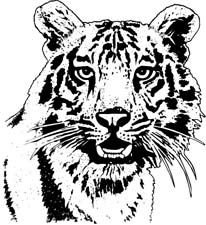 "Be Civil to all, Sociable to many, Familiar
with few, Friend to one, Enemy to none".
Benjamin Franklin
If you have any questions
about class cancellelations due to Snow or Bad Weather... call the school.1 877 KARATE U.S.A. - there will be a
special message of cancellation, if not classes will be held.
| Master
Alvin Aguilar |
Man
of the Year - Filipino Arts |
| Sifu
Rick Armstrong |
Sifu
of the Year - Pai Lum Tao |
| Sensei
Brandon Baird |
Man
of the Year - Isshin Ryu |
| Tiffany
Danielle Frost Bell |
Recognized
Youth Female Competitor of the Year - Isshin Ryu |
| Whitney
Nicole Frost Bell |
Recognized
Youth Black Belt of the Year - Isshin Ryu |
| Grand
Master John Beluschak |
Grand
Master of the Year - Hapkido |
| Renshi
Zurriane Bennett |
Renshi
of the Year - Goju |
| Shihan
Olaf Bock |
International
Man of the Year |
| Master
Bob Brewer |
Master
of the Year - Kaju Bujutsu Kwai |
| Guro
Chester Brown Jr. |
Man
of the Year - Filipino Arts |
| Michiel
& Kim Burnham |
Outstanding
Parent Support |
| Sifu
Kelly Butler |
Outstanding
Instructor of the Year |
| Master
Benson Campbell |
Outstanding
Martial Artist of the Year |
| Professor
Marcel Carles |
Man
of the Year - Judo |
| Professor
Wayne Carmen |
Pioneer
Award |
| Master
Richard Cazares |
Man
of the Year - Tae Kwon Do |
| Sensei
Anthony Charles |
International
Kickboxer of the Year |
| Master
William Chestnut Jr. |
Master
of the Year - Judo |
| Sifu
Stephen Colkett |
Instructor
of the Year - Kung Fu Wushu |
| Sifu
Dug Corpolongo |
Sifu
of the Year - Chinese Arts |
| Renshi
Janos Czari |
International
Renshi of the Year |
| Master
Tim Dahle |
Master
of the Year - Chinese Arts |
| Master
John Daigle |
Golden
Life Achievement Award |
| Shad
S. de Guzman |
Mixed
Martial Arts Instructor of the Year |
| Renshi
Bejamin Deleon Sr. |
Renshi
of the Year - Ju Jitsu |
| Master
Eutimio Delgado |
Outstanding
Contribution |
| Master
Clifton Dillehay |
Master
of the Year - Kenpo |
| Shihan Soraya Holguin Dujarric |
International Shihan of the Year |
| Grand Master Don Le Fields |
Diamond Life Achievement Award |
| Guro Jeff (Stickman) Finder |
Universal Man of the Year |
| Sifu Delroi Flood |
Sifu of the Year - Wing Chun |
| Grand Master Gary Findley |
Outstanding Contribution to the Martial Arts |
| Renshi Jens Fricke |
Renshi of the Year - Shotokan |
| Sensei Buddy Garrett |
Instructor of the Year - Ju Jitsu |
| Christopher Gallio |
Recognized National Youth Competitor of the Year |
| Master Willie (Bear) Galloway Jr. |
Outstanding Master Award |
| Grand Master Joseph Gonzales |
Distinguished Martial Artist |
| Curtis W. Hanson |
Recognized Youth Competitor of the Year - Isshin Ryu |
| Grand Master Don Harries |
Grand Master of the Year - Wu Chun Tang |
| Dr. Matthew Harris |
Master of the Year - Kakuto Shin Ryu |
| Professor Kenneth Haugland |
Head Founder of the Year |
| Dr. Jose Luis Hinojosa MD/MA |
Black Belt Competitor of the Year |
| Master Bernd Hohle |
International Martial Artist of the Year |
| Dr. Richard Hoyer |
Most Distinguished Master of the Year - Isshin Ryu |
| Professor A. Perry Hubbs II |
Recognized Outstanding Achievements - Business |
| Shihan Gerald Jenkins |
Outstanding Shihan Award |
| Grand Master Steven Jimerfield |
Law Enforcement Defensive Tactics Instructor of the Year |
| Shihan George Johnson |
Outstanding Shihan of the Year |
| Sensei Thomas Jordan |
Recognized Total Commitment to the Martial Arts |
| Grand Master Lance Kellogg |
Outstanding Grand Master of the Year |
| Dr. Michael Kelly DO. |
Outstanding Man of the Year - Martial Arts |
| Professor Patrick Kennedy |
International Man of the Year - Kenpo |
| Master
Noparat Khotphankul |
Outstanding
Master of the Year |
| Sensei
Logan Lee Jr. |
Instructor
of the Year - American Freestyle Kenpo Karate |
| Ethan
Leigh |
Recognized
Competitor of the Year - Kang Moo Kwan |
| Sensei
Tom Leigh |
Instructor
of the Year - Kang Moo Kwan |
| Master
Jerry Lewis |
School
of the Year - Oak Ridge Academy of Martial Arts |
| Shihan
Malcolm Livingston |
Distinguished
Shihan of the Year |
| Grand
Master Walt Lysak Sr. |
Living
Legend Award |
| Master
Walt Lysak Jr. |
Universal
Master of the Year |
| Hanshi
Edmund Maciejzcyk |
Universal
Award of the Year |
| Grand
Master William Maier |
Outstanding
Grand Master of the Year |
| Sensei
J. Daniel Mikeska |
Instructor
of the Year - Jeet Kune Do |
| Master
David Mosser |
Master
of the Year - Seiei Kan Karate |
| Sensei
Nic Mosser |
Recognized
Black Belt Youth Competitor of the Year |
| Master
Pat Munk |
Man
of the Year - Kenpo |
| Master
Johnny Murphy |
Master
of the Year - Weapons |
| Sensei
Howard Nuchols |
Black
Belt Instructor of the Year - Isshin Ryu |
| Dr.
Eliseo Olivares |
Man
of the Year - Kakuto Shin Ryu |
| Master
Dave Park |
Master
of the Year - Isshin Ryu |
| Sensei
Harold (Skip) Parr |
Black
Belt of the Year - Kakuto Shin Ryu |
| Sensei Kevin W. Pence Sr. |
Instructor of the Year - San Chai Na Kempo |
| Sifu
Alfredo Posada |
Instructor
of the Year - Spiritual Kung Fu |
| Professor Michael Rash |
Master of the Year - Martial Arts |
| Sifu
Jeffery Richardson |
Instructor
of the Year - Kajukenbo |
| Shihan
Greg Robinson |
Shihan
of the Year - Goshin Budo Ju Jitsu |
| Shihan
H.G. Robby Robinson |
Most
Distinguished Humanitarian Award of the Year |
| Grand
Master Ovid Rodriguez Jr. |
Distinguished
Grand Master of the Year |
| Sensei
Ovid (Sugarbear) Rodriguez III |
Recognized
Junior Black Belt of the Year |
| Sensei
Ricky Rojas |
Policeman
Award of the Year |
| Master
Richard Ryan |
Master
of the Year - Self Defense |
| Master
Joseph Saladino |
Man
of the Year - Ju Jitsu |
| Sifu
Johann Sasynuik |
Man
of the Year - Chinese Arts |
| Professor
Vicent Sands |
Soke
of the Year |
| Grand
Master Jack Searcy |
Grand
Master of the Year - Kenpo |
| Master
Doyle Seiber |
Distinguished
Master of the Year |
| Sifu
Lorenza Shamuon |
Recognized
Outstanding Teen Martial Artist of the Year |
| Master
Tom Shamuon |
Man
of the Year - Kung Fu |
| Grand
Master Fred Simon |
Grand
Master of the Year - Tae Kwon Do |
| Sifu
Stanley Smith |
Sifu
of the Year - Kajukenbo |
| Sensei
Star Spikes |
Instructor
of the Year - Miyama Ryu Ju Jitsu |
| Grand
Master James Stevens |
Universal
Grand Master of the Year |
| Professor
Clifford Steward |
Grand
Master of the Year - Self Defense |
| Grand
Master Daryl (Bigfoot) Stewart |
Most
Distinguished Grand Master of the Year |
| Shihan
Candy Soto |
Woman
of the Year - Martial Arts |
| Dr.
Jimmy Steger, Soke |
Sports
Medicine Award |
| Professor
Daniel Torres |
Martial
Artist of the Year - Judo |
| Professor
Kelly Townsend |
Contribution
to the Martial Arts |
| Sensei
Robert Valentin |
Instructor
of the Year - U.S. Fighting Arts |
| Sensei
Kenton Van Zandt |
Instructor
of the Year - Zujitsu |
| Shihan
Kenneth Lee Vasquez |
Universal
Shihan of the Year |
| Professor
Samuel Vasquez PhD, MS/MA |
Distinguished
Man of the Year |
| Master
Jay Vera |
Master of the Year - Kajukenbo |
| Master Dominick Violante |
Master of the Year - Kempo |
| Grand
Master Gary Wasniewski |
International
Grand Master of the Year |
| Shihan
Mike Whitworth |
Shihan
of the Year - Moo Sul Kwon |
| Grand
Master Moses Williams |
Head
Founder - Spiritual Kung Fu |
| Sensei
Mark Willis |
Man
of the Year - Martial Arts |
| Master
Mark Young |
Eternal
Loyalty - Ju Jitsu |
| Master
Chebbi Zouhaier |
International
Master of the Year |
 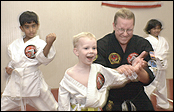
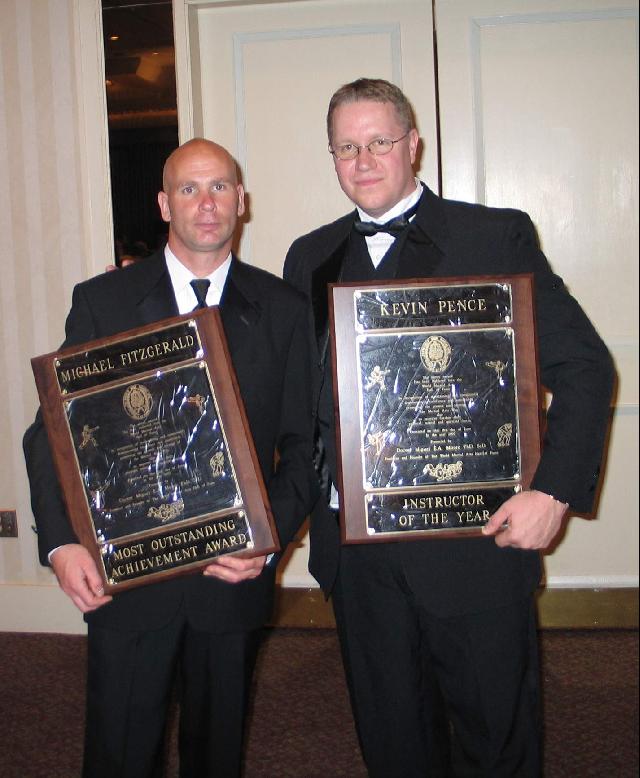
The control of a large force is the same principle as the control of a few men: it is merely a question
of dividing up their numbers.
Sun Tzu
Aberv.
MA = Martial Art(s)
MMA = Mixed Martial Arts
FMA = Filipino Martial Arts
TMA = Traditional Martial
Arts
CMA = Chinese Martial Arts
BJJ = Brazilian JiuJitsu
JJJ = Japanese JuJitsu
WC = Wing Chun
WT = Wing Tsun
KM
= Krav Maga
VT = Vale Tudo
TKD = Tae Kwon Do
RBSD = Reality Based Self Defence
MT = Muay Thai
KF = Kung Fu
WTF = World Taekwondo Federation
ATA = American Taekwondo Association
KO = Knock Out
TKO = Technical
Knock Out
HWD = HwrangDo
XMA = Extreme Martial Arts
KK = Kyokushin Karate
GJJ = Gracie Jiu-jitsu
JKD = Jeet
Kune Do
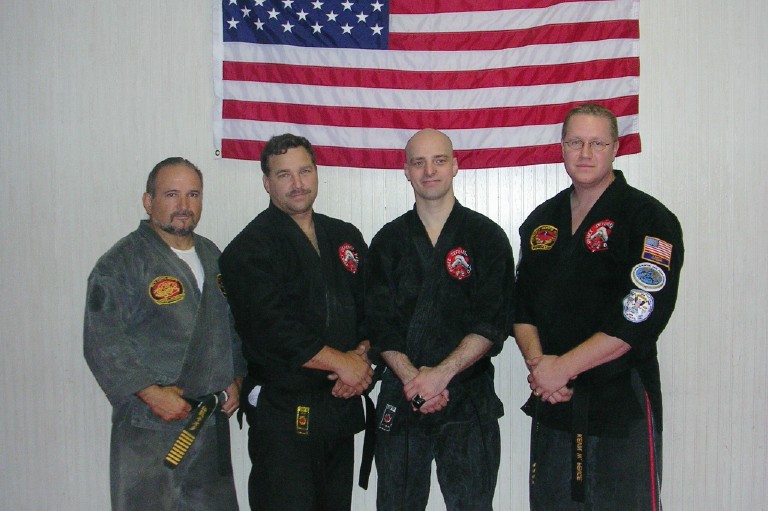 P.S.D.A.
Black Belts
ROKUDAN
KEVIN P. **********6th
Deg Black Belt ROKUDAN
GODAN
YONDAN BRYON P. *********4th Deg Black Belt YONDAN - Sensei
SANDAN
SCOTT T. ******** 3rd Deg Black Belt SANDAN- Sensei
MATT W.*********3rd
Deg Black Belt SANDAN
TREVOR F. ***********3rd Deg. Black Belt SANDAN MIKE R. ***********2nd
Deg. Black Belt SANDAN - Sensei
ANDREW D. *********2nd Deg. Black Belt SANDAN - Sensei
NIDAN
ADRIAN C . *************2nd Deg. Black Belt NIDAN
NISARG C.************2nd Deg. Black Belt NIDAN
TOM A. ***************2nd Deg Black Belt NIDAN
NUKE G. *************2nd Deg. Black Belt NIDAN
SAI G.**************2nd
Deg. Black Belt NIDAN SRAVIA G. **********2nd Deg. Black Belt
NIDAN
KAT P. *************2nd Deg. Black Belt NIDAN
SHODAN WALLY H. ***********1st
Deg Black Belt SHODAN
STEVEN G. ***********1st Deg Black Belt SHODAN ABU T. ***********1st
Deg Black Belt SHODAN DILLON
S. ***********1st Deg Black Belt SHODAN JOE L. *************1st
Deg Black Belt SHODAN KATHY P. *************1st Deg Black Belt SHODAN SHAWN
G. ************1st Deg Black Belt SHODAN ALEX
Mc. *********1st Deg Black Belt SHODAN MIKE L.**************1st Deg Black Belt
SHODAN KUNAL **************1st Deg Black Belt SHODAN KRISHNA S. *********1st Deg Black Belt SHODAN JIMMY
W.*********1st Deg Black Belt SHODAN
CHRIS B..*********1st Deg Black Belt SHODAN
SHAWN B.*********1st Deg Black
Belt SHODAN
JANUK.*********1st Deg Black Belt SHODAN
DAVID H.*********1st Deg Black Belt SHODAN
The above said rank of
all these fine students are current ranks as of 3-4-2012. *Blue indicates that the Student is not
certified at this time. ANINDITA D.****1st Deg Black Belt SHODAN VIJAY.***********1st
Deg Black Belt SHODAN KEN E.**********1st Deg Black Belt SHODAN CURTIS
*******1st Deg Jr.Black Belt SHODAN CHRISTINE Y.***1st Deg Jr. Black Belt
SHODAN JEFF Y.*********1st Deg Jr. Black Belt SHODAN MAYONK
**********1st Deg Jr. Black Belt SHODAN RAGHAV T. *********1st Deg Jr. Black Belt SHODAN RUSHAB
T. ********1st Deg Jr. Black Belt SHODAN NICK
S. ***************1st Deg Jr. Black Belt SHODAN PAUL K. **************1st
Deg Jr. Black Belt SHODAN AKASH M . ********1st Deg
Jr. Black Belt SHODAN RICHA C.***********1st Deg
Jr. Black Belt SHODAN MAYONK
**********1st Deg Jr. Black Belt SHODAN
CORINA S.***************1st Deg Jr. DEEP D.****************1st
deg. Jr. KRISTIE B.**************1st deg. Jr.
| Shihan , Trevor, and Nisarg ,with Sensei Kevin |
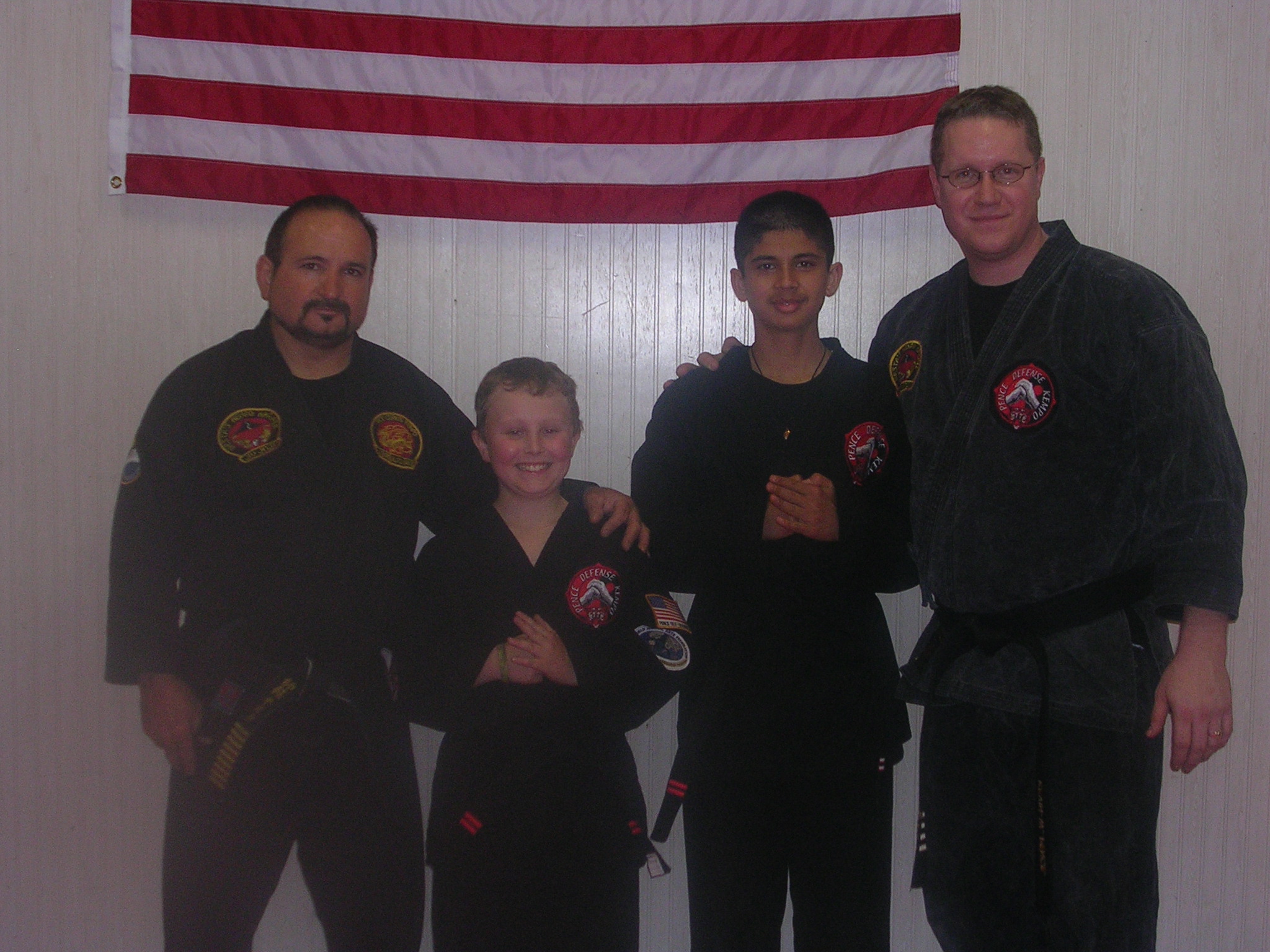
|
| Congrats Nidan X 2 |
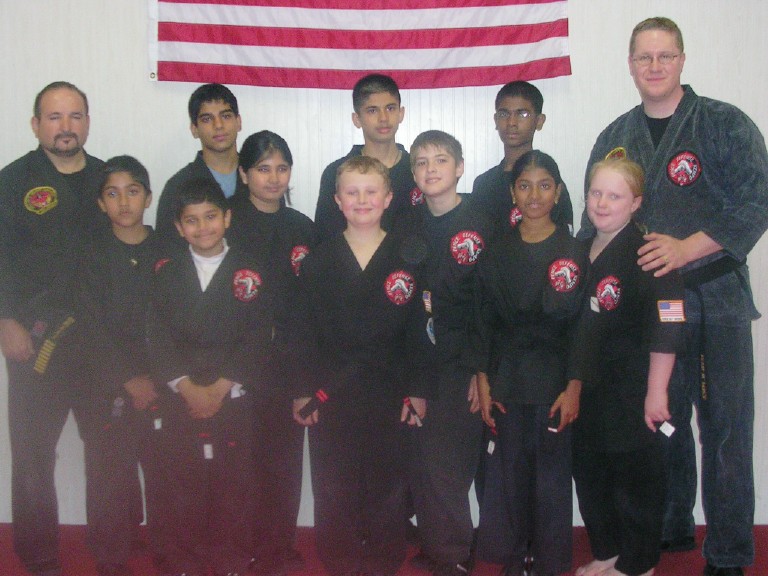
|
| Black Belt test 5/29/05 |
Some of the names of Black Belt students will Not appear
here, In some cases this is just an oversight. Others have been deliberately taken off my list.
Why you may ask?
The student proved to be disrespectful, or was deceitful towards
others in or out of the dojo, or used his or her Art in a dishonorable way, and disgracing the rank of all Black
Belts everywhere! They shall no longer hold any rank within these walls.
Ranks are valid only as indications
of one's current skill level, maintained through active training. If you are no longer training, you are not considered to
hold any rank in this dojo. Sensei may reduce or advance your rank as he sees fit. Promotion or reduction of rank
is a teaching tool, providing an objective evaluation of your progress.
However preoccupation with rank shows
a lack of understanding of the arts.
Responsibilities
Everyone has their own responsibilities; some people have
greater responsibilities than others. It is important that students take care of their responsibilities. When a student reaches
a more advanced level they are given more responsibilities. Senior students have many responsibilities that they must take
of.
An important responsibility that a senior student must carry
out is to be a role model for other students. They should be performing the correct tasks as much as they can. Whether it
is standing in front position, or leading the class in exercises. Every little task they do should be the right way. Beginner
and intermediate students follow by example, and sometime Sensei is not going to be that example. There are times when senior
students will lead the class through exercises. The students will have to execute each exercise as they want the other students
to do them. For example, when the students do push ups they will make sure to keep there back straight, and go down and up
all the way. If senior students are not being good role model the whole class will be affected.
Another responsibility a senior student has is to help out
with classes. The help of senior students makes classes run smoother. Students can get more done in a shorter amount of time
when senior students help out. A couple of things the students do to help out with classes are: lead the class through exercises,
lead the class through stretching, help lower belts out with their material, and help Sensei demonstrate.
When senior students demonstrate with Sensei they have many
more than one responsibility. First of all they must stand there and do exactly what Sensei says. Then they must react to
what Sensei does in a manor that will help the class understand what is happening. If a student that is demonstrating with
Sensei responds wrong he or she may get hurt or the other students may not understand what has just happened.
A more personal responsibility of a senior student is they
must keep themselves in line. Keeping oneself in line can be defined as being reliable, and not falling back from where he
or she stands in his or her journey through life. It is important that a senior student does not begin to slack off. If a
senior student begins to slack off lower ranks will be affected. The lower ranks may not strive to be as good as they should
be since the ranks above them slack off. This means that senior ranks need to keep practicing, and always try to better themselves.
If the senior students take care of themselves the whole school will profit from it.
It is always important for senior students to stay responsible.
It helps them and it helps the people around them. The whole school is affected by each and every student it has, and if all
the students do their task to the best of their abilities the school will continue to be a wonderful place to train.
Someone e-mailed me this article in 2002, I thought
it would be well read on this page . While I didn't write it I wish I had.
Those who make peaceful revolution impossible
will make violent revolution inevitable.
John F. Kennedy
Our students are, quite literally, the future of our school, thus we expect much from them. White Belt Not
all white belts will become black belts but all black belts were once white belts. The rank of white is the first and thus
the one of the most important levels. The white belt level is the foundation for all learning at the Pence Self-Defense Academy.
The basic information taught at this level is absolutely crucial to advancing in the system. Students who spend the time required
to master the basics will always make the best martial artists. The nafanchin forms are the frist to be taught and are one
of the keys to learing the rest of the forms Yellow Belt
The student begins the long road of learning pinan forms in the System.
This enables individuals to challenge their self discipline as well as providing a structured way to practice basic stances
and techniques. One Pinan is the foundation for every form that will be learned at the higher ranks.The yellow belt student
is also required to begin refining the basics learned at white belt. Orange Belt
The student
has demonstrated that the they have the makings of a student who may stay. Given this initial show of perseverance, we
teach the orange belt their second Pinan at this level. During this time at orange belt, students will continue to refine
all information previously learned, as well as learning a variety of new techniques. Purple Belt
At purple belt level, students are introduced to the frist Kata, where they will see their first form that has "soft"
elements.
Blue Belt
A student with this rank has completed
a full year of study at Pence Self-Defense Academy. Sparring gives the student the opportunity to implement techniques in
a more realistic setting than regular class drills provide. The second year of study will also require students to learn a
variety of specific historical information about the System along with the continued study of physical techniques. Green
Stripe
This is when the student begins specific study of individual Kempo founders. The historical research component
of our system is designed to enrich the martial arts experience for our students. Green Belt
This rank
begins the advanced period of study at Pence Self-Defense. At the green belt level, we start to prepare students for the responsibility
of being a black belt. There is a longer waiting period between promotional tests, a greater amount of historical information
to learn, and the possibility of serving as an assistant instructor for our beginner youth class. The green belt must develop
and maintain a high degree of humility to continue learning the advanced aspects of Ping. Belt ~ Brown
Stripe This rank represents a refining period for
our students. Only one new form is taught so that previous information can be reviewed and improved. This is a somewhat critical
stage, since the next belt is Brown. A high percentage of Brown Belts continue onto the Black Belt level, thus we take this
final pre-Brown step very seriously. Brown Belt ~ 2 Stripes
This is, in many ways, the final learning
stage prior to Black Belt. We continue to prepare the 2nd brown student for the role of Black belt. If the student chooses,
they can begin their Black belt project paper preparations by researching possible topics and discussing them with the instructional
staff. Brown Belt ~ 3 Stripes
Students at this rank will spend approximately six months refining everything
they have learned in the past 3-5 years of study. Conditioning is also priority, since the Black belt test is an 6 hour endeavor.
Students are also expected to fully embrace the idea of professionalism at this stage. Any lapses in dojo etiquette and/ or
character must be addressed prior to Black Belt certification. 1st deg. Brown students will often be used as assistants to
instructors. The future of our school rests, partly, on the continued development of quality martial artists.
Sempai (pron.
sim-pie)
An assistant teacher, model, or senior
student. This term is applied to
a student who is training to be a sensei but
has not fulfilled the requirements to become a full instructor.
"God gave us Two Ears, one Mouth."
"Kevin, be the one who listens, not the one who
tells" my Father would say to me as a young boy. I have found over the years that my Father was right.
As a general rule " listen rather than speak", while
in the dojo, as constant talk and chatter to your training partner or Sensei is nothing more than a time wasting
drill, that demonstrates a lack of discipline and self-control.
You may think your comments are important or cool, but
most students prefer to hear what the instructor has to say. It maybe harsh but, Expulsion from class, either temporarily
or permanently is usually the result from lack of self-control in this area of behavior.
"THE SAFETY OF ALL, MUST COME BEFORE ALL ELSE "
K.P. Sensei
"Support your athlete "
The best reason to wear an athletic supporter is so you can wear a protective cup. For the unfamiliar:
supporter come in two flavors: plain, and a kind of marsupial version that accepts a removable cup made of very hard plastic.
A well-placed blow in this region is not only agonizing; it can destroy a boy or a man!
While most boys and men can get by without athletic supporters, a lot more ought to wear cups.
Kids these days have helmets for practically everything—I wouldn't be surprised to see my sons wearing them for violin
practice. But surprisingly few boys wear cups for sports. I would make my sons do for Little League, Football or Hockey and
most defiantly in the dojo. If you have a son in this dojo, get him a cup; if you are a man in this dojo you should never
take a class without it!
"no ouch just ouss" !
k p sensei
BALANCE
With life moving at a faster pace, we can find that we're just too busy to stop
and reflect on our priorities. Too busy to consider what is important. That's also where the principles of Balance
help Try you to step back, see the big picture in relation to your health and well being, decide, based on a systematic
and complete picture, what has to be done and do it!!The Balance "Ying/Yang" is an important symbol
for balance and a constant reminder of the three main aspects of health - mind, body, spirit.
BEAR FOOT
Why train barefoot? This is a question that I get all the time. To say that,"to train
without shoes is traditional" may be the best thing I can say about it . The origins of bare foot training started when men
of the culture and period did not were shoes there for it made sense to train in bear feet to make it more realistically for
self defense If those same men where training today I think they would wear shoes. Ask your self this, how many times do you
go outside in your bare feet? (Having said this now I still like to take off my shoe and train 1 or 2 times for every 10 times
I train.) There is much to be said for training in a nice pair of Pine trees or Asics Gels, they are made for martial artist
and give good support for your feet . Odds are it is what you will have on if you do have to defend yourself or your loved
ones out in the real world. So give shoes a try ,It may take some getting use to at first but after some time you
will feel great .
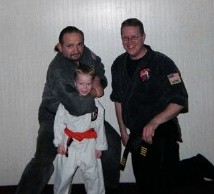
|
| Shihan Nesta and D.W. |
Careful what you ask for.
In the middle of a forest, there was a hunter
who was suddenly confronted by a huge, mean bear. In his fear, all attempts to shoot the
bearwere unsuccessful. Finally,
he turned and ran as fast as he could.The hunter ran and ran and ran, until he ended up at the edge of a very steep cliff.
His hopes were dim.
Seeing no way out of his predicament, and with the bear closing in Rather quickly, the hunter got
down on his knees, opened his arms, and exclaimed, "Dear God! Please give this bear some religion!"
The skies darkened
and there was lightning in the air. Just a few feetshort of the hunter, the bear came to an abrupt stop, and glanced round,
somewhat confused.
Suddenly, the bear looked up into the sky and said, "Thank you, God, for the food I am about to
receive...."
"A sharp tongue and a dull mind are usually found in the same head!"
click here to play video
click here to play video
|

